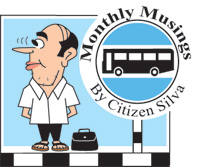Sunday Times 2
A bridge too far
View(s):It was from that famous Sri Lankan journalist of yesteryear, Tarzie Vittachi, that I first heard about the Katussa theory.
“You see, putha” Tarzie told me once, addressing me as he was wont to do with young cub reporters, “when it comes to India-Ceylon relations, we must always remember that our country is no bigger than a katussa when compared to our elephant-sized neighbour. Despite all Sir John’s big talk to Nehru, we are not in a position to argue or fight with this monstrous opponent that can easily stamp on us and destroy us.
 But at the same time we should not forget that this huge elephant called India is not a single entity, but an animal made up of a whole lot of katussas that have got stuck together. These katussas have different religions, speak different languages and don’t always agree with each other. In other words, India is a nation made up of various states and territories with fissiparous tendencies”.
But at the same time we should not forget that this huge elephant called India is not a single entity, but an animal made up of a whole lot of katussas that have got stuck together. These katussas have different religions, speak different languages and don’t always agree with each other. In other words, India is a nation made up of various states and territories with fissiparous tendencies”.
During the course of my journalistic life I learned many new words from Tarzie – but this word ‘fissiparous ‘ (tending to break up) has remained one of my favourites.
India’s original fourteen states and six territories that were created by the States Reorganisation Act of 1956 have today (as a result of not only India’s innate fissiparity but also the forcible annexation by the elephant of small states like Sikkim and Goa) become 29 states and 7 territories.
Now one thing we Sri Lankans have always been fiercely proud of is the fact that for the past 2,500 years, we have remained independent of India. Invaders from India like the Cholas and Pandyans may have in the past conquered parts of our island (like the Romans in 55 BC and the French in 1066 did to Britain), but these regions were reconquered and Lankan sovereignty re-established – allowing this country to maintain its independence from the mainland.
Even the British, leaving India to be ruled by the rapacious East India Company until as late as 1858, declared Ceylon a crown colony in 1802 and administered (under a governor directly responsible to London) as a unit quite independent from Britain’s Indian conquests.
So it was quite perturbing for us to learn of our Prime Minister’s grand idea to build a bridge (quite inappropriately termed a ‘Hanuman Bridge’) from Sri Lanka to India with the intention of facilitating trade and other forms of intercourse between our two countries.
No less a person than Indian Transport Minister Nitin Gadkari has been promoting the project – stating just a couple of months ago that the Indian government is planning a feasibility study of the Rs 230 Billion project to establish road connectivity between India and Sri Lanka.
Quite apart from the fact that such a bridge/tunnel will cross some highly productive fishing grounds in the Palk Strait and impede the flow of sand and water from the Palk Bay to the Gulf of Mannar, such a bridge which will allow folk from south India to drive – or even cycle or walk or hitch a ride on a train – across to Sri Lanka.
In my humble opinion, such a bridge will be the beginning of the end of Sri Lanka as an independent nation. The benefits of this bridging project will accrue almost entirely to India (with perhaps even spinoffs to Nitin Gadkari and his Purti Group).
These days, anyone coming in an airplane from India to Sri Lanka (unless of course they came as the Indian Peacekeeping Force did with their goats and Cheetahs between 1987 and 1990) is subject to stringent security and customs checks at the airport of departure and entry.
Since the 1994 establishment of a rail and road link across the English Channel between France and England, the British and French have found that conducting such checks on drivers and motorcyclists at the Channel Tunnel terminals at Folkestone and Calais is not as easy or as effective in preventing smuggling of goods and illicit immigrants from the less favourable to the more favourable country across the road link.
Legend has it that in ancient times, Hanuman and his Vanara army built a bridge across the strait from India to Sri Lanka, which permitted this army of monkeys to invade our country.
Let us hope that our new government will not pave the way for Sri Lanka to be inundated by another invasion of Monkeys from India – who will find our island a rich green paradise compared to the dirty, arid and poverty stricken wastes of the worst parts of India.

